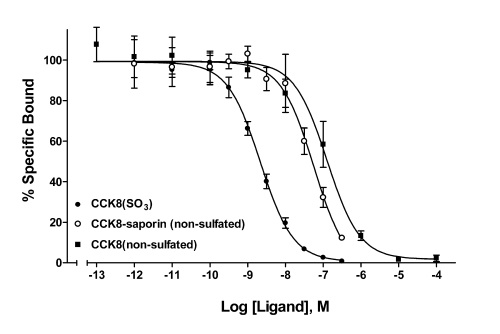Our thanks to Drs. Frank Porecca, Victory Hruby and Josephine Lai, Department of Pharmacology, The University of Arizona Health Sciences Center for sharing the results of their studies.
Cholecystokinin (CCK) is widely distributed in the central nervous system and the gastrointestinal tract. The 33-amino acid peptide contains a carboxyl terminal octapeptide sequence Asp-Tyr-Met-Gly-Trp-Met-Asp-Phe-NH2 which confers the biological activity of CCK, and where the tyrosine residue occurs in sulfated form. This octapeptide, CCK8(SO3), has high affinity for the two structurally-defined CCK receptors types, CCK1 and CCK2, based on radioligand binding analysis using [125I]CCK8(SO3) in transfected HEK293 cells that express either the human CCK1 or human CCK2 receptors (Table 1). On the other hand, the non-sulfated form of CCK-8 exhibits lower affinity for both CCK receptor types when compared with that of the sulfated form. The non-sulfated form is also moderately selective for the CCK2 receptors (Table 1).
Table 1. Affinity of CCK-8 or CCK-8-saporin for the human CCK1 and CCK2 receptors based on competitive inhibition of [125I]CCK-8 binding to HEK293 cells that stably express hCCK1 or hCCK2 receptors.
| Affinity (Ki, nM) | ||
| Ligand | hCCK1 | hCCK2 |
| CCK8(SO3) (sulfated) | 0.8 | 1.5 |
| CCK8 (non-sulfated) | 800 | 125 |
| CCK8-saporin (non-sulfated) | ND* | 56 |
A covalent conjugate of non-sulfated CCK-8 to saporin (CCK-SAP, Cat. #IT-31) was synthesized and evaluated for the toxin conjugate’s affinity for the human CCK receptors in transfected HEK293 cells (Figure 1 and Table 1). CCK-SAP exhibits similar affinity for the hCCK2 receptors as non-sulfated CCK-8. The affinity of CCK-SAP for the hCCK1 receptors was not determined because, based on the findings seen in the CCK2 receptors, it is likely that the affinity of CCK-SAP for the CCK1 receptors would be similar to that of non-sulfated CCK-8, and the cost of such assays would be prohibitive due to the high concentrations of CCK-SAP needed. Conjugation of saporin to CCK-8 does not significantly alter the affinity of CCK-8 for CCK receptors and should therefore be effective in targeted-lesion of CCK2 expressing cells by CCK-mediated internalization of saporin.

Acknowledgments: The authors thank Dr. Alan Kopin for the generous gift of the cDNAs for hCCK1 and hCCK2, and the technical assistance of Dr. Shouwu Ma and Brian Lew.
